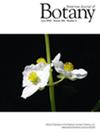Biosilicification in monocots: Comparative analysis highlights contrasting patterns of deposition
Abstract
Premise
New insights into biomineral uptake and sequestration are important for understanding how plants grow. Some plants accumulate silica accretions in precise locations in particular cells. Among monocots, controlled biosilicification occurs in several different forms and is restricted to commelinids and orchids.
Methods
We utilized energy-dispersive x-ray spectroscopy (EDX/EDS) mapping technology on leaf transverse sections to explore the diverse silica deposition patterns in a range of monocots. The results were evaluated using character optimizations on existing phylogenies.
Results
Our optimization indicates at least two independent evolutionary origins of phytoliths among monocots, with secondary losses in some lineages. Silica that accumulates in the cell lumen occurs mostly in bundle sheath cells or epidermal cells, often associated with sclerenchyma. In Bromeliaceae and Rapateaceae, small phytoliths occur in the walls of occluded epidermal cells overlying sclerenchyma. In Dasypogonaceae, phytoliths accumulate in the lumen of epidermal cells. Cell-wall bound silica occurs in the epidermal cells of some commelinids (Commelinaceae, Cyperaceae and Poaceae). There is a close association between silica deposition and the presence of ferulic acid, except possibly in orchids. Records of high silica concentration in leaves are not always correlated with deposition. We found no silica deposition in leaves of some aquatic commelinids, despite evidence for silica uptake and presence of ferulic acid.
Conclusions
Our ongoing comparative investigations using EDX data not only extend our knowledge about biomineral inclusions in plants, but also highlight their structural and biochemical complexity. This study suggests that the diversity and relatively restricted phylogenetic distribution of monocot phytoliths is at least partly attributable to cell chemistry.


 求助内容:
求助内容: 应助结果提醒方式:
应助结果提醒方式:


